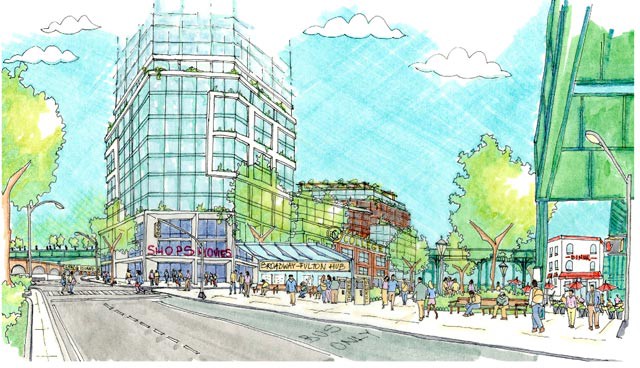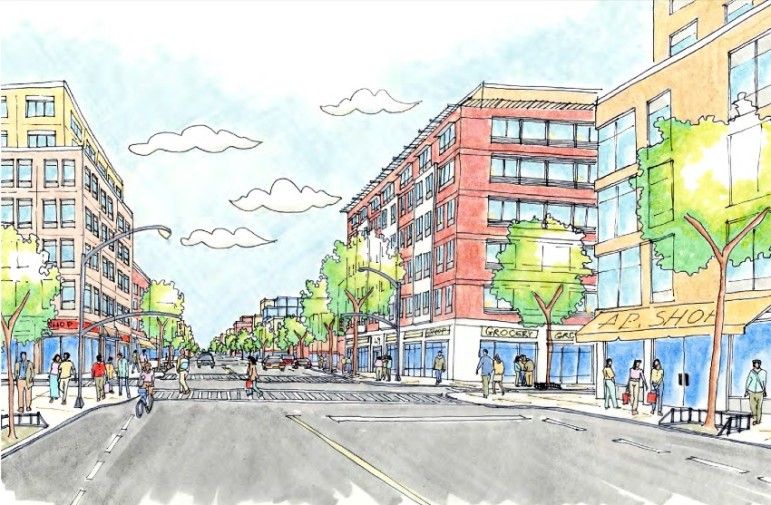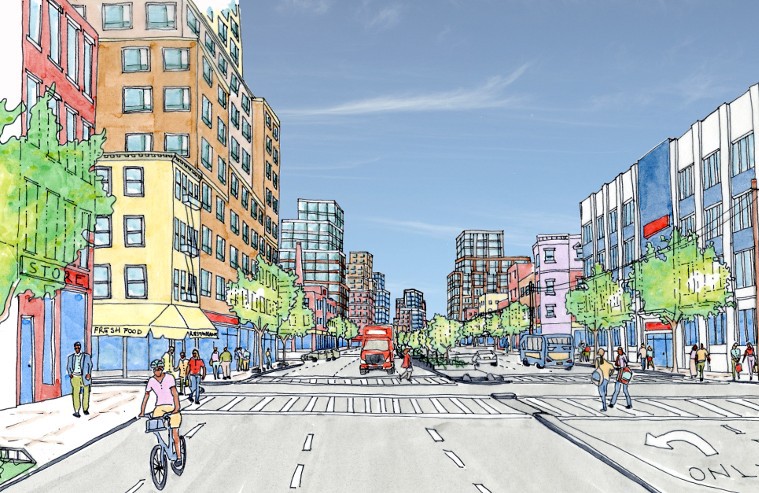Affordable For Whom?
by Brendan O’Connor

Debbie Medina was twelve or thirteen years old in 1977 when an electrical blackout that lasted twenty-five hours hit New York City. Hundreds of stores were looted, more than a thousand fires responded to, and hip hop catalyzed. At the time, Medina was living with her family in an unfinished housing development on the Southside of Williamsburg, a historically Puerto Rican neighborhood. “I remember that our buildings for the next day, our buildings didn’t have no water, but across the street they have water. Small little homes,” she said in a recent interview. “We made a line from across the street, the small houses, into one of our big buildings. We were taking water in pails and passing it on so we got water up to the 25th floor. I thought that was amazing. Even back then, it was fun, because I was young, but when you think about it now, we were together with the unity. There was some kind of unity there.” Medina would go on to spend nearly three decades working as a community organizer and tenants’ rights activist with Southside United HDFC, better known as “Los Sures.” Now, she’s running for state Senate. “This election is just another rent strike,” she recently told The Nation. “The difference is, it’s not just one landlord versus some of the tenants. It’s all of the landlords versus all of the tenants.”
Medina, who still lives on the Southside, is running as a democratic socialist against well-funded and long-reigning incumbent Martin Dilan, father of Assemblyman Erik Dilan, and an ally of the late Brooklyn power broker Vito Lopez. (Lopez resigned from his assembly seat in 2013 after he was fined $330,000 for sexually assaulting multiple female staffers.) According to campaign finance data compiled by the National Institute on Money in State Politics, the senator has received upwards of $177,900 from groups with ties to the real estate industry (mostly groups associated with landlords, brokers, and developers). Two industry lobbyist groups, the Real Estate Board of New York and the Rent Stabilization Association, have given Dilan $26,950 and $20,250, respectively. “One of the first things my father told me when I said I was going to run, he told me everyone that goes up to Albany gets messed up,” Medina said. “I told him, ‘I’ve been doing this for so many years, I’m going to be 53 years old,’ I told him. ‘I haven’t gotten messed up yet. What makes you think I’m going to get messed up when I get to Albany?’”
“Let me tell you, as an organizer for thirty years, people may think it doesn’t happen but, people do come to you. Landlords do come to you, and they try to influence you in all kind of way, whether it’s money. I’ve had landlords that have asked me ‘Your kids, do you want to put your kids in private school?’ I’ve had all kind of offers,” Medina said. “It’s not that I don’t like money! Don’t get me wrong, it’s not that I don’t like money. Because I do like money. Whoever doesn’t is just a liar, I’m sorry.” She laughed. “I will not take any money from anyone. I’m not going to be bought off that way,” she said. “I’m not going to compromise in anything like that. I never have and I never will. I never will.”
That is not to say that she doesn’t know how to negotiate: Medina and Southside United’s organizing pressured Two Trees Management into finding space for another hundred units of affordable housing in its redevelopment of the Domino Sugar Factory, bringing the planned total from six hundred to seven hundred. “I’m a friend of Two Trees! I fought them for Domino — and don’t think that I’m satisfied with the amount that’s there — but they’re friends of mine. But I will not take their money. I’m friends with them because we have to deal with one another.”
One issue on which Medina has not compromised, however — even as many of the major tenants’ rights groups retracted their opposition — is Mayor Bill de Blasio’s housing plan, which the City Council overwhelmingly approved last week. The plan, which New York heralded as de Blasio’s “version of Obamacare: an imperfect but monumental legacy program on which he staked his political credibility,” is composed of two major programs, Mandatory Inclusionary Housing and Zoning for Quality and Affordability, that in turn comprise three major changes: It will rezone fifteen neighborhoods across the city, likely beginning with East New York, to encourage development; mandate that any new residential development in those rezoned neighborhoods include at least twenty-five percent rent-regulated apartments; and loosen the rules regulating contextual zoning districts, allowing developers to build higher than they would otherwise be permitted in exchange for including more, affordable units in those buildings.
Real-estate interests, however, suggest that the whole thing will remain toothless until the state comes up with a replacement for the lapsed 421-a tax abatement, without which developers have long (and somewhat dubiously) held they can’t afford to build anything other than luxury condos. Nevertheless, speculators have descended upon the area, drawn not only by low property values but, as New York reported earlier this year, by an abundance of homes that are in foreclosure: In the last two years, property values in the zip codes affected by the mayor’s housing plan have risen by thirty to forty-five percent. Investors are especially interested in transit rich areas, like that surrounding Broadway Junction, where the A, C, L, J, and Z subway lines meet, and which offers a transfer to the Long Island Rail Road. (In 2014, Broadway Junction saw a ridership of just over three million people, up from 2.8 million in 2009.) Under the mayor’s plan, the city’s Department of Housing Preservation and Development will finance twelve hundred units of affordable housing in the first few years following the rezoning. A “significant” number of those will be affordable to families with “very low” and “extremely low household” incomes City Planning Chairman Carl Weisbrod said after the commission approved the plan last month. According to DNAinfo, however, he did not specify what constitutes a “very low” or “extremely low” income bracket.
Much of the early opposition to the mayor’s plan, at least from political interest groups on the Left, stemmed from fears about what “affordable housing” actually means, and who qualifies for it. (Any given conversation with an anti-gentrification activist will almost inevitably include the pointed question, “Affordable for who(m)?”) The original plan required developers to build apartments “affordable” to people making sixty percent of the area median income — or about $47,000 for a family of four. After negotiating with City Council, in March, that was lowered to forty percent of AMI — about $31,000. And so, Politico New York reports, following months of criticism, the city’s largest housing group, Real Affordability for All, agreed to back de Blasio in exchange for a promise from the mayor that City Hall would “conduct an in-house study” into the group’s remaining concerns. (Namely, how to ensure that union workers are hired at new developments in rezoned areas and how to encourage more affordable housing.) “This plan is a big step forward for our city,” Maritza Silva-Farrell, campaign director for RAFA, said. “As community organizers and advocates, our job has been to push hard and raise our voices for the real affordability and good jobs that low-income New Yorkers so desperately need. We know Mayor de Blasio shares our core progressive values, and he has listened to our concerns.”

Medina, who lived through the 2005 rezoning that made Williamsburg what it is today, has remained staunch in her opposition. (As did the Metropolitan Council on Housing. “This plan is not an affordable housing plan, it’s a gentrification plan,” executive director Ava Farkas told DNAinfo.) That rezoning, Medina said in a statement earlier this month, “spawned hyper-gentrification, drove up rents across the neighborhood, delivered far too little affordable housing, and in the end only helped two groups of people: the real estate developers and the landlords, who grew rich off of luxury condos and high rents. It is the wealthy, not working people, who will benefit from this plan. The affordable housing in the plan is well and good. It is also a fraction of what is needed.” Her statement continued: “Land is our most precious resource in New York City. It is very clear what we need: heavily subsidized, tenant-controlled, deeply affordable housing. We may never get that if we rezone now.”
According to one study, from the University of Michigan, the New York metropolitan region had the second-highest rate of Black-White segregation and the third-highest rate of Latino-White segregation in the country. Government-subsidized housing, where it exists, is decrepit — Akai Gurley died in part because the New York City Housing Authority didn’t have enough money to keep the lights on. (NYCHA housing is currently under federal investigation for elevated blood-lead levels.) Structural racism isn’t just in the laws: It’s in the walls.
Medina’s critique of housing policy in New York City, that the 2005 Williamsburg waterfront rezoning “spawned hypergentrification,” cuts through nostalgic handwringing over every shuttered DIY music venue and every newly-opened upscale coffeeshop. So much of the creative class’s anxiety over its role in the process of displacement focuses on self-recrimination over things like going to a newer bar instead of a neighborhood dive and taking an Uber home instead of the subway, and the next morning buying an iced latte from a place that employs baristas instead of a cup of coffee from the corner bodega. This, however, takes signifiers of a phenomenon for the phenomenon itself — these are not concerns about living ethically but consuming ethically, and there is no ethical consumption under capitalism. It is one of capital’s great coups, however, to confuse the two, and to further render housing little more than a commodity.
The fact of the matter is: Individual gentrifiers cannot do anything about gentrification. Certainly one can make an effort to be a thoughtful neighbor, and a gracious member of a new community, but everyone has to live somewhere, and if everyone who benefited from the inequities of a systemically unjust world held themselves personally accountable for that injustice they would go mad. Where one chooses to live makes no difference one way or another in terms of preventing inequity, because the very availability of the choice — to be able to choose where to live — betrays the existence of the inequity.
After the city council passed the mayor’s housing plan last week, he took reporters on a tour of his old neighborhood in Park Slope, lamenting his predecessor’s poorly executed rezoning there. “All along Fourth Avenue now we’d have hundreds of affordable apartments and a lot of people from the neighborhood would’ve been able to stay who probably weren’t able to otherwise. And you think about the lost opportunity, it’s very frustrating. But the good news is, now we’ve turned the corner,” he told Politico New York. “This is like the perfect picture of everything wrong.” De Blasio, a councilman representing Park Slope at the time, voted in favor of the rezoning.
When I spoke to Medina on Monday, her disappointment was clear. “I really thought we were going to have an opportunity, I have to tell you,” she said. “I definitely think it’s going to be same thing that happened to us here.” (New York Senate District 18 stretches across north Brooklyn from Williamsburg and Greenpoint, through Bushwick, to East New York.) And yet: “I live here and I’m not planning on moving from here,” she said. Her most immediate concern is strengthening rent regulation: Preserving affordable housing where it already exists, and making it more difficult for landlords to harass tenants out of apartments that could attract higher rents. “One of the things that I always used to tell my tenants was that through unity, there’s change. Remember: This is your sister. She’s your sister, he’s your brother, and we have to look out for one another. What happens to him can happen to you, so always think about that, and always be together,” Medina continued, remembering passing the pails of water across the street and up twenty-five flights of stairs during the ’77 blackout. “We created that and that’s how it was. All of that — that changed me.”

Medina told me she didn’t identify as a socialist until recently. “It was the Bernie campaign. That really brought it out,” she said. “But those ideas have always existed in our community,” she continued, citing the Young Lords, a Puerto Rican nationalist group that was founded in Chicago and spread to New York, and the Puerto Rican Socialist Party. (The Young Lords began as a street gang in Chicago’s Lincoln Park neighborhood in the late fifties before reorganizing in the sixties as a civil rights group, inspired by the Black Panthers and in reaction to widespread police abuse and frequent evictions in the barrios.) “To me, being a socialist is being able to say, ‘You’re not going to control me. You’re not going to control what’s going to happen here. You’re not going to come and tell me, “We’re just going to build a seventy percent luxury and thirty percent for low income.”’ It’s actually the community having the control, the power to be able to make that kind of decisions,” she said. “We’re the ones who live here. Who better than us to be able to say, ‘This is what should happen.’”
“We all practice socialism every single day of our lives — when we’re doing something that’s not just only for us, but for everyone else in the building. When you have a say,” Medina said. “’Socialism’ isn’t scary. You know what’s scary? That you’re going to be displaced from your apartment, that there’s luxury housing coming up, and you’re not the one that’s living there. That’s what’s scary.”
A Poem By Shabnam Piryaei
by Mark Bibbins, Editor
the river was stunned the children did not know her name
we are destructive and thirsty and blooming.
we are thirsty and guided and resilient.
we are blooming and macheted and destructible.
we are gazing at a stained rubberband in the snow we are on our hands
and knees barking at the dogs we are spanked with wet hands we are
mowing the lawn in the sunlight we are yelling at our brother
who is a fence who will die who was never born.
we are running from the fire we are dwelling in the ashes.
we are fishing filled magically with flaws we are licking the paint
from the car door imploring the lock to rise.
we are steam and cake and dancing ferociously on the carpet.
we are watching the life drain from a bee on the sidewalk.
we are rippling though we ate one thousand gray pills we are flashes
of light we are blood diagrams in the bathroom sink.
Shabnam Piryaei is the author of the books Ode to Fragile (Plain View Press, 2010), Forward (MUSEUM Books, 2014), and Nothing Is Wasted (forthcoming).
How To Make Blowjobs Boring

“In modern times, sex slang is all work and decreasing play, and ‘blow job’ leads the way towards labor. Words, slang included, ring with psychic resonance, and ‘job’ is not a value neutral term. Most of us do our jobs with reluctance. Sure, there’s a payoff, and there’s satisfaction in a job well done, but if we’re honest with ourselves, our jobs tend not to bring us as much joy as we’d hope. We are all thirsty Marxists, somewhat alienated from our labor and definitely wanting more. And this is the issue with the whole family of ‘job’ sex slang. As much as violent terminology shapes our thinking and the ways in which we talk about fucking, so too do capitalist terms. It says something about our relationship to sex when we think of sex in terms of labor.”
— Yeah, whatever, Emma Goldman. Listen up: It’s “blowjob.” One word. Let’s not have this discussion again.
Photo: Shutterstock.com
We're All Characters In The Courtney Love RPG That Is The Internet
“Courtney Love called me late one night. I was one of her (many) AOL IM buddies. (‘I love the internet,’ Love said. ‘It’s like a video game about me.’)” [Via]
Destroyer, "My Mystery (DJ johnedwardcollins@gmail.com remix)"
Here’s Destroyer’s Dan Bejar on this track:
We recorded a song called “My Mystery” a year and a half ago. Kind of a light number, vaguely danceable. Wistful, looking back not unfondly on time spent and dull misadventures had within the dead-as-a-doornail music industry. And the feeling of where it leaves you, like a rat in the middle of the ocean, though not as harsh as that; as if rats could swim an ocean’s length.
I’m sure we can all relate. Also, is it just me or are DJs getting a little lazy about their branding these days? Anyway, new Destroyer, I’m not going to ask too may questions. Get it here. And enjoy!
Sweets Lazarused
You might enjoy this interview with the fellow who brought back Hydrox Cookies, Astro Pops, Tart n’ Tinys, Bonkers! Fruit Chews and Wacky Wafers, among other nostalgic treats.
A$AP Nast, A$AP Twelvyy, A$AP Rocky,"Presidents"
I haven’t been this excited by a collaboration between a bunch of A$APs since they all got together with Method Man back in 2013. I think for the rest of the campaign season I would only like my political commentary provided in A$AP form. Enjoy.
New York City, March 29, 2016

★★★ Lumpy sun and darkness played over the unnatural yellow surface of an immense spill of old popcorn by the side of the movie theater. Pigeons and a starling were at it with no real haste. Individual kernels were scattered up the block, casting their individual shadows behind them. All day, the light was hyper-precise. Every strand of hair showed on every person’s head, every pucker at the seams of their puffy coats. Taxicab grilles coming down Fifth Avenue looked as sharp as thinning shears. For once the wind chill was worth caring about; the thermometer reported spring but the wind made the shoulders brace against winter. Furry hoods were back in evidence. Heavy ripples raced along a gutter puddle.
America Reminds You That You're Homely Wherever You Are
Not a “10” in the US? Then not a 10 overseas. Beware of being lured into buying expensive drinks or worse — being robbed. #springbreakingbadly
— Travel — State Dept (@TravelGov) March 30, 2016
I mean, look, I’m not stupid. I’ve got a mirror. I go outdoors. I went to high school. I know I’m not a movie star. I can tell when people turn away because they think there’s something off about my face. I hear the laughs. You get used to it, after a while. It doesn’t ever stop hurting, not really, but you learn to not be surprised. You don’t get to be my age without realizing how other people see you. And like I said, it never feels good, but if you remind yourself to be accepting of who you are and you work on the qualities you can control, you can make yourself into someone who other people won’t recoil from, someone whose inner light shines bright enough that at least a few other people will see it. You make do with what you have and you try to be happy with the person you’ve become. And then one day, out of nowhere, your own government reminds you that not only are you no beauty but that the only reason anyone would ever want to buy you a drink is to rob you, or worse. And then all you want to do is cry. Fuck you, State Department. Now I’m voting Trump for sure.
Translator Slapfight!
If you feel grossed out by the recent contretemps concerning “selfies,” Genius, or that guy in the Observer who… something, I don’t know — or if you in fact feel grossed out for engaging in or promoting engagement of discussions about “selfies,” Genius, or whatever the hell it was that guy in the Observer… do you think they even edited that or do you think they were just like, “It doesn’t matter, media Twitter is going to take it and run with it for us either way” — then perhaps you might find this debate over literary translation to be something of a gross-out eraser. There is a bit of background reading that you might have to do but it’s a small price to pay for feeling like you’ve involved yourself in something other than “selfies,” Genius, or God, I don’t fucking know, it seems like you’d have to exert a phenomenal amount of effort to be simultaneously as imperial and impenetrable as that guy in the Observer was and yet you come away with the impression that it all came impossibly easy to him, right? I mean, what the hell even was that?
